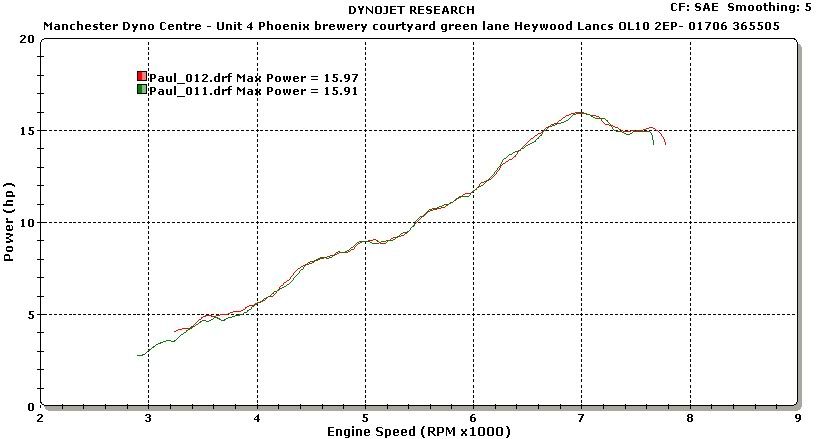muggy 225 with 60mm crank and standard rod, 30mm oko carb and sterling pipe sx200 gears with 15/47 http://i1045.photobucket.com/albums/b45 ... torque.jpg
http://i1045.photobucket.com/albums/b45 ... o/paul.jpg
just under 16bhp @ 7000rpm and similar torque. not great i would say for a 375quid kit plus crank??
gonna have some mods done to barrel and then hopefully get another dyno run and see the improvements...
mugello 230
-
Wayne Miller
- registered user
- Posts: 345
- Joined: Wed Jan 07, 2009 12:52 pm
- Main scooter: Vespa 50 Special (Rotax Proto)
- Location: Rothwell, Northants
- Contact:
paulski wrote:
Stay tuned..............
Hi Wayne
Think there is a problem with your dyno results on the RPM signal i'll try to explain.
The dyno only measure the torque produced at the rear wheel and then calculates the BHP based on the RPM signal and the rotational axis of the drum ( which is a fixed number of 5252 calculated using rotational diameter of force or Pi x 2ft diameter of 6.2832)
1 HP = 550 ftlbs / sec
= 33,000 ftlb / min
therefore 33,000 ft/lb / 6.2832
= this magic number of 5252
So the Torque x RPM / 5252 = the calulated horsepower
So in your case the measured value of 16.37 ftlbs of torque x 6800 RPM / 5252
Should then = 21.19 BHP
as the torque is almost always correct and the 5252 value is fixed then i'd assume the RPM value could be wrong.
Also would be nice to see the air fuel ratio graph
Hope this helps
Pete
Think there is a problem with your dyno results on the RPM signal i'll try to explain.
The dyno only measure the torque produced at the rear wheel and then calculates the BHP based on the RPM signal and the rotational axis of the drum ( which is a fixed number of 5252 calculated using rotational diameter of force or Pi x 2ft diameter of 6.2832)
1 HP = 550 ftlbs / sec
= 33,000 ftlb / min
therefore 33,000 ft/lb / 6.2832
= this magic number of 5252
So the Torque x RPM / 5252 = the calulated horsepower
So in your case the measured value of 16.37 ftlbs of torque x 6800 RPM / 5252
Should then = 21.19 BHP
as the torque is almost always correct and the 5252 value is fixed then i'd assume the RPM value could be wrong.
Also would be nice to see the air fuel ratio graph
Hope this helps
Pete
If you pick up a starving dog and make him prosperous, he will not bite you. This is the principal difference between a dog and a man.
- Rich_T
- Dealer
- Posts: 540
- Joined: Fri May 29, 2009 8:07 pm
- Main scooter: Li Special
- Location: Birmingham
- Contact:
Sonny is dead right, there is something big time fishy with those graphs.
Firstly if you could clarify the units as the torque graph is showing NM not Foot pounds.
Either way, one of the key elements to look for is the cross over between the two graphs which takes place at the magical...5252rpm (or there abouts, I put it about 5244 but it is sermantics). Below this rpm torque is higher than BHP and above that rpm BHP is always higher (assuming you are using the same scale of foot pounds to BHP, some graphs will use different scales one on the LH side and the other on the RH side).
Additionally, because of the basic maths that calculate BHP from torque the following features should be evident on the graph. A constant torque reading (flat line) between 5-8K rpm will result in an increase in BHP at a set rate. You graph shows the torque curve following the BHP and this is totally wrong unless I have catastrophically miss-read the graph some where.
Some real basic checks are required as fundamentally it is way off.
Firstly if you could clarify the units as the torque graph is showing NM not Foot pounds.
Either way, one of the key elements to look for is the cross over between the two graphs which takes place at the magical...5252rpm (or there abouts, I put it about 5244 but it is sermantics). Below this rpm torque is higher than BHP and above that rpm BHP is always higher (assuming you are using the same scale of foot pounds to BHP, some graphs will use different scales one on the LH side and the other on the RH side).
Additionally, because of the basic maths that calculate BHP from torque the following features should be evident on the graph. A constant torque reading (flat line) between 5-8K rpm will result in an increase in BHP at a set rate. You graph shows the torque curve following the BHP and this is totally wrong unless I have catastrophically miss-read the graph some where.
Some real basic checks are required as fundamentally it is way off.
Just noticed as well the torque scale being in NM and not ftlb
1 ftlb = 1.3555 NM so your max torque was 12.08 ftlb
So 12.08 x 6800 / 5252 = 15.64 HP
So the dyno is correct I also had a look at some of the Mugello 225's weve had here on our dyno and they are 15.5, 15.72 to 16.8 so yours is normal but the torque and hp graph should cross at the magic 5252 value which is odd also AF values would laos be a clue to how your engines set up.
Pete
1 ftlb = 1.3555 NM so your max torque was 12.08 ftlb
So 12.08 x 6800 / 5252 = 15.64 HP
So the dyno is correct I also had a look at some of the Mugello 225's weve had here on our dyno and they are 15.5, 15.72 to 16.8 so yours is normal but the torque and hp graph should cross at the magic 5252 value which is odd also AF values would laos be a clue to how your engines set up.
Pete
If you pick up a starving dog and make him prosperous, he will not bite you. This is the principal difference between a dog and a man.
I've heard many conflicting stories on the Mugello 225. I think it's a well known fact that out of the box there no better than their smaller brother the 186. I had my 225 stage 5 tuned by Reaper when i bought it from Cam Lam and when i first had it dyno'd it got 18.5 bhp at Chiselspeed. I've since had to change exhaust from a Scorpion to a Devtour so should get it re-done but the performance is about the same as before.
here is the fuel/air graph to go with the dyno- run http://i1045.photobucket.com/albums/b45 ... ulfuel.jpgSonny wrote:Hi Wayne
Think there is a problem with your dyno results on the RPM signal i'll try to explain.
The dyno only measure the torque produced at the rear wheel and then calculates the BHP based on the RPM signal and the rotational axis of the drum ( which is a fixed number of 5252 calculated using rotational diameter of force or Pi x 2ft diameter of 6.2832)
1 HP = 550 ftlbs / sec
= 33,000 ftlb / min
therefore 33,000 ft/lb / 6.2832
= this magic number of 5252
So the Torque x RPM / 5252 = the calulated horsepower
So in your case the measured value of 16.37 ftlbs of torque x 6800 RPM / 5252
Should then = 21.19 BHP
as the torque is almost always correct and the 5252 value is fixed then i'd assume the RPM value could be wrong.
Also would be nice to see the air fuel ratio graph
Hope this helps
Pete
- drunkmunkey6969
- Moderator
- Posts: 2838
- Joined: Sun Jan 04, 2009 1:42 pm
- Main scooter: '69 Lambretta GP
- Location: North Yorkshire
- Contact:
You are running lean.paulski wrote:here is the fuel/air graph to go with the dyno- run http://i1045.photobucket.com/albums/b45 ... ulfuel.jpg
See our YouTube scooter channel for Tech-help: https://www.youtube.com/c/TheScooterFactory/videos


